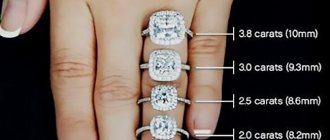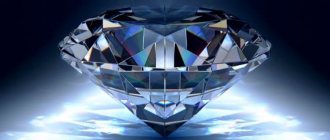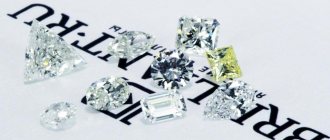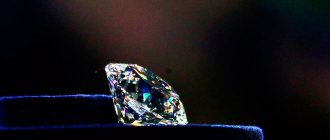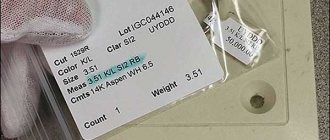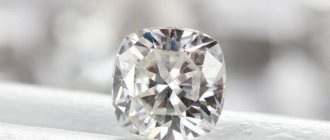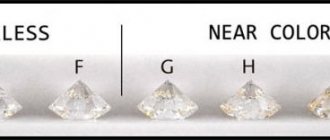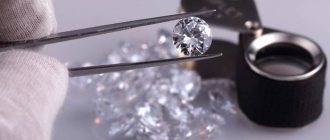This figure shows the measured and visually assessed proportions that affect a round diamond.
A specific set of terms are used to describe the parts of a diamond. Each part of a diamond contributes to its appearance.
A standard round diamond has 57 or 58 facets. The table facet (table facet) is usually the largest facet in a diamond. It helps collect light and either reflects it back to the observer's eye or directs it deeper into the diamond. The crown's facets, composed of 8 beveled facets, 8 stars and 16 top halves, collect and diffuse light, creating brightness, fire and a sparkling pattern of light and shadow. The pavilion's wedges, consisting of 16 lower halves, 8 main culets and an auxiliary culet, reflect light back through the crown into the viewer's eye. All of these facets work together to create a diamond's unique appearance.
Average girdle diameter
The diameter of a round diamond is the distance from the edge of the girdle edge to the opposite edge of the girdle edge, straight through the center.
Since even very well-cut round diamonds are never perfectly round, the diameter is measured in several places, noting the minimum (smallest) and maximum (largest) measurements. The average diameter of the girdle is calculated using the formula accurate to hundredths of a millimeter (0.01 mm):
Average girdle diameter = (minimum diameter + maximum diameter) ÷ 2
This value is used in calculating certain proportions such as landing size, overall depth, crown height and pavilion depth.
Total depth in percentage
The overall percentage depth of a round brilliant is the ratio of the distance from the table to the culet to the average diameter of the girdle, expressed as a percentage to the nearest tenth of a percent (0.1%).
The total percentage depth is a calculated value obtained using the following formula:
Total depth % = (depth ÷ average girdle diameter) x 100
Site percentage
The table percentage of a round brilliant is the average of four measurements (from the edge of the crown facet to the opposite edge through the center), expressed as a percentage of the average girdle diameter. Recorded to the nearest whole percent (1%).
The site percentage is a calculated value obtained using the following formula:
Pad% = (average pad size ÷ average girdle diameter) x 100
Table size can have a significant impact on the appearance of a diamond, especially when associated with certain combinations of crown and pavilion angles.
How to make a diamond in a ring appear larger?
There are several factors that affect how large a diamond appears when set in a ring: the type of setting, the cut of the stone, and its shape.
How does the ring setting affect the size of the diamond?
Some settings leave more of the diamond surface visible than others.
For example, prongs do not cover the same amount of the stone's surface as rim or channel settings.
A setting that holds the diamond with four or six prongs can be a good choice if you want to show off as much of your stone as possible and make it appear larger.
Diamond shape and its effect on size.
Some diamond shapes tend to look larger than others, even if they have the same carat weight.
If you want to create the illusion of size, look for wide shapes. For example, a square asscher cut diamond will appear larger than a narrow marquise cut diamond.
However, it's not just the shape that matters when it comes to appearance.
Sometimes, the way a diamond is cut can make it look smaller even though its shape is wide and square. This is why you should also consider the importance of cut.
Cut as a factor in diamond size.
The way a diamond is cut can greatly affect how it looks. Deeper cuts appear smaller than shallower ones, as long as the stones being compared are of the same carat weight.
For example, the princess cut has more depth compared to the emerald cut.
In general, if you want a diamond whose surface appears larger when set in a ring, look for shallow cut stones.
Don't forget, however, that each cut has certain ideal proportions, and if the depth of the diamond you buy deviates significantly from the standard for a particular cut, its brilliance may be reduced.
This is especially true for brilliant cuts such as round.
Diamond size and finger size.
Finally, be sure to consider the wearer's hand when choosing the size of the diamond in the ring.
Wide fingers can make a diamond appear smaller than it appears when placed on a hand with thinner fingers.
Also, consider the fact that elongated diamond shapes make the fingers appear longer, while wider shapes emphasize the width of the hand.
Crown angle
The crown angle is the measured angle between the plane of the main facet of the crown and the plane of the landing. Recorded as the average of eight crown angle measurements to the nearest one-half degree (0.5°).
The angle of the crown can significantly affect the appearance of the diamond. Typically, crown angles between 32 and 36 degrees create attractive, vibrant, and fiery diamonds when paired with the correct table percentage and pavilion angle.
Ideal diamond proportions
Among gemologists, the cut is often highlighted as the most important element of the 4Cs - the one you shouldn't skimp on because it has the biggest impact on the stone's appearance. But what is it really? And why don't manufacturers pay attention to this? Cut is a measure of how well a diamond would be cut from a piece of dull, rough diamond that has been dug out of the ground and transformed into a sparkling gemstone that makes women's hearts flutter around the world. Cut is a key factor that determines how well a stone reflects light, hence how you see the sparkle of a diamond. A well-cut diamond may appear larger than a poorly cut diamond of the same size. The cut also affects the color and hides flaws in the diamond. It is very important. The cut actually consists of three elements:
- proportion;
- symmetry;
- polishing
We'll look at each of these in turn - what they really mean and what to look for when choosing diamonds for your jewelry - starting with the most important ones.
A perfect round diamond has mathematically perfect proportions.
In fact, the first person to try to calculate the ideal proportion of a diamond was a mathematician. Marcel Tolkowsky published a book called Diamond Design as part of his doctoral dissertation back in 1919. In it, he calculated a shape that maximizes the diamond's brilliance and fire (sparkling sparkle) of the stone. In the process of his research, he invents the round brilliant cut - today this is the most common cut of diamonds. I consider it classic. Although there have been some changes to the mathematician's work over the past 95 years, his calculations still form the basis of how we evaluate the cut of a round diamond. But why are these proportions so important and what happens if you deviate from them? Let's look at examples.
1. The diamond is too tall.
If the diamond is cut too deeply, light will be reflected from the bottom of the stone at the wrong angle. The stone may appear smaller from above and this may result in shadows in the center of the diamond. Such diamonds are called “nailhead”, which literally translates as “nail head”.
2. The diamond is too flat.
A diamond that is cut too shallow allows more light to pass through and refracts less of it, again making the stone less brilliant. A superficially cut diamond can produce an effect called fisheye, which gets its name because a dark ring appears at the top of the stone, reminiscent of the cold, dead eyes of a haddock, before it reaches its final resting place—salt and vinegar. Nailhead and fisheye effects can greatly devalue a stone that is considered to be of high quality by all other diamond grading criteria. And this is an important reason for choosing a high cut grade.
3. What you need.
A diamond cut to "Excellent" or "Ideal" proportions will reflect enough light for you to see the radiant sparkle and fire that makes people so in love with diamonds.
Measuring the cut of a diamond.
Diamond cut is graded using a scale that was originally developed by the Gemological Institute of America (GIA) and is now used throughout the world. It takes into account the proportions and angles on a diamond's diagram and serves as a guide to how well each stone fits within those proportions and therefore how well it should sparkle.
Strength and durability.
In addition to whether or not a diamond will sparkle, the cut can also affect the stone's longevity. Although diamonds are stronger than any other gemstone, they can still be damaged if they are cut with a very thin edge or without a tenon. Durability lies mainly in the slightly crude-sounding term "girdle" and the less interesting name "culet".
Girdle The girdle or girdle is the most prominent edge that runs around the diamond and is the surface on which the rings are firmly held. • A thin girdle may mean that the edges of the stone are brittle, so it is likely to be less durable. • A belt that is too thick can mean that most of the stone is concentrated in the middle of the belt, meaning that the stone will appear visually smaller than a well-cut stone of the same weight.
Kaleta Kaleta is the lowest point of a diamond, a thorn, or rather, the absence of a thorn. If the bottom of the diamond has been adjusted and the tenon has been sawed off, then it is said to have a large culet, and if it is sharp as a thorn, then it does not have a culet. In the old European cut, you can often find diamonds without culets. This was done in order to make the stone more impact resistant when it is attached to the ring. However, when viewing the diamond from above, a black dot may be visible. Ideally, your culet should be either very small or not exist at all.
Why aren't all diamonds perfectly cut?
Why aren't good rough diamonds cut to meet reference cutting standards? The reason is that diamonds can often be worth more if they are cut incorrectly but are larger in size. For example, the same rough diamonds can be cut in different ways. Either it can be cut into two 3-carat fair cut diamonds and sold for a total of about $45,000, or it can be cut to create two 2.2-carat round diamonds with excellent durability and an excellent cut grade. ” or “ideal”, which cost only $35,000.
Jewelers play on people's obsession with diamond sizes and ignorance of the importance of cut. Therefore, cutters are trying to get the maximum benefit and this is quite understandable. Unless you want to end up with a large, poorly cut diamond that won't sparkle at all, make sure that when choosing the largest size you choose the highest cut level that is available for your budget.
Choice of cut class . Experts recommend "Ecxellent" or "Ideal" (the terminology sometimes changes depending on the seller) to ensure you get a dazzling diamond that will make your engagement ring perfect. It's worth spending some of your budget on the best cut diamonds available to you, as this is a key factor in determining how well your diamond will sparkle. A well-cut stone with excellent sparkle and brilliance will offset warmer color tones and lower clarity grades and make your jewelry dazzling. Avoid "low" diamonds at all costs, even if it means your budget can now stretch to a 3 carat stone, it will still look dull and lifeless and the trade-off is not worth it.
Crown height in percentage
Crown percentage height is the distance measured from the landing to the point of intersection of the main facet of the crown with the girdle chamfer in relation to the average diameter of the girdle, expressed as a percentage. Recorded to the nearest half percent (0.5%).
The percentage crown height is a calculated value obtained using the following formula:
Crown height% = (average crown height ÷ average girdle diameter) x 100
Pavilion corner
The pavilion angle is the measured angle between the main facet of the pavilion and the plane of the site. The average of eight pavilion angle measurements is recorded to the nearest 0.2 degrees.
Subtle differences in pavilion angle can have a significant impact on the appearance of the diamond. For example, steep pavilion angles can create dark areas under the diamond table.
What is a carat of a diamond
Diamond is one of the most expensive precious stones. This is a cut diamond. The name means "sparkling". To add shine and convey the play of color, jewelers make many edges on the nugget, rounding the corners or leaving them sharp.
In classic jewelry, the top of the mineral looks like this after cutting:
- round;
- square;
- rectangular;
- oval;
- triangular.
The mass of a nugget is calculated in carats. The term comes from carato: the Italian name for the pod of the Ceratonia tree. The seeds of ceratonia fruits weigh 0.2 grams. This measure began to be used in antiquity, since there were no other ways to evaluate diamonds at that time.
The size of 1 carat diamonds differs according to the type of cut:
| Cut type | Number of faces | Width/length or diameter | Weight | ||
| mm (mm) | cm (cm) | Milligram | Gram | ||
| Round | 57(classical) | 6.4 | 0.64 | 200 | 0.2 |
| Square | 49, 57, 72 | 5.55 | 0.555 | ||
| Oval | 57 | 7.7/5.9 | 0.77 x 0.59 | ||
| Pear-shaped (drop-shaped) | 55, 56 | 5.8/8.6 | 0.58 x 0.86 | ||
| Heart-shaped | 57, 58 | 6.7/6.5 | 0.67 x 0.65 | ||
| “Marquise” (oval with pointed ends on the narrow side) | 55 | 5.6/9.8 | 0.56 x 0.98 | ||
| Emerald (rectangular) | 57, 65 | 6.4/4.9 | 0.64 x 0.49 | ||
| Equilateral triangle | 19–52 | 6.5/6.5 | 0.65 x 0.65 | ||
Carat is important in determining value. The least valued are crumbs (dust) and small cut diamonds up to 0.3 mm. The sparkle in them is barely noticeable. Large (from 1 ct) or medium (0.3–0.999 ct) nuggets cost 15 times more than the same weight of small-caliber minerals. Their sparkling shine (brilliantation) is clearly expressed.
In 1907, the value of 1 ct was officially approved - 200 milligrams. The International Metric Committee has established that the size of a diamond and other precious stones is indicated in this unit of weight, and other gems are indicated in grams.
Pavilion depth in percentage
Percent Pavilion Depth is the depth of the diamond's pavilion, measured from the culet to the intersection of the pavilion and girdle, in relation to the average girdle diameter, expressed as a percentage. Recorded to the nearest half percent (0.5%).
The average pavilion depth percentage is a calculated value obtained from the following formula:
Pavilion depth% = (average pavilion depth ÷ average girdle diameter) x 100
Diamond Size and Weight Chart
Diamond size refers to the diameter of a round cut diamond. Please note that the table shows the approximate sizes of diamonds weighing from 0.2 to 15 carats, corresponding to the “A” cut group. The size of a diamond depends not only on weight, but also on the proportions and symmetry of the cut. Diamonds are made by hand, so they can have the same weight and different sizes.
| 0.2 carat – 3.8mm | 0.25 carat – 4.1mm | 0.33 carat – 4.4mm | 0.5 carat – 5.1mm |
| 0.6 carat – 5.3mm | 0.75 carat – 5.7mm | 0.9 carat – 6.2mm | Diamond 1 carat 6.4mm |
| View diamonds ranging in size from 4 to 6.5 mm (Diamond Expert diamond catalog) | |||
| 1.25 carat – 6.9mm | 1.5 carat – 7.3mm | 1.75 carat – 7.7mm | Diamond two carats 8.1mm |
| 2.25 carat – 8.5mm | 2.5 carat – 8.8mm | 2.75 carat – 9.1mm | Three carat diamond 9.4mm |
| 3.5 carat – 10.0mm | 4 carats – 10.4mm | 4.5 carat – 10.8mm | Diamond 5 carat 11.0mm |
| 5.50 carat – 11.3mm | 6 carat – 11.7mm | 7 carat – 12.4mm | 8.50 carat – 13.1mm |
| 9 carat – 13.5mm | Diamond 10 carat 14.0mm | 12.35 carat – 15.1mm | 15 carat – 16.0mm |
In the Diamond Expert diamond catalog you can find out exact data on the sizes of diamonds weighing from 0.26 to 1.05 carats.
Length of the lower wedge in percent
The percentage of the lower wedge is the ratio of the length of the lower wedge to the distance from the girdle to the culet, expressed as a percentage. Recorded as the average of eight measurements to the nearest five percent (5%).
Wedges that are too short or too long can negatively affect the appearance of the diamond, especially its pattern.
Percent girdle thickness is the average thickness of a diamond's girdle, measured at eight positions at its widest points (the "hills") and expressed as a percentage of the average girdle diameter. Positions “hills; - These are the “thick places” located where the main edges meet. Recorded to the nearest half percent (0.5%).
Why aren't diamonds sold in standard carat weights?
Did you know that all those 1-carat diamonds may not weigh exactly 1 carat? Stated values are approximate.
Although diamond carat weight is expressed in standard values such as 0.5, 0.75, 1, etc., in reality, it is rare to have a stone that weighs exactly one of these numbers.
A one-carat diamond can actually be 0.95 or 1.05 carats. This is why you shouldn't expect two diamonds with the same carat value to be exactly identical in weight.
In fact, it is completely normal that the diamond weight is not an exact number and it is usually noted that this number is an approximation.
This is normal practice and is usually not hidden; you can always find the exact carat value on the diamond certificate (or grading report).
It is often impossible to cut a diamond so that its carats exactly correspond to the standard size.
A jeweler cutting a diamond crystal will generally try to obtain one or more stones that are of the highest possible quality.
For example, a carat can be deliberately reduced by cutting out segments that contain many natural imperfections, thereby improving the clarity of the diamond.
Or the jeweler may want to get rid of some parts of the crystal to create a more proportional cut, which increases the sparkle of the stone.
However, the carver will also try to use as many raw materials as possible and minimize waste. As a result, the cut stone will have a weight that will be close to one of the standard values, but there will always be some deviations.
What is the normal carat deviation?
Typically, the actual weight of a diamond will vary between 0.06 and 0.08 of its advertised value.
For example, a 0.94 carat diamond would be sold as a one carat stone. Or, a diamond that is stated to be 0.75 carats may actually be closer to the 0.8 number.
You can always ask the salesperson at the jewelry store about the exact weight of the diamond he shows you. You can also check this number on the diamond grading report - it should be mentioned there.
Description of girdle thickness
The thickness of the girdle is visually assessed as the range between the thinnest (minimum) and thickest (maximum) areas (between “valleys” and hills”).
Descriptions of girdle thickness include very thin, very thin, thin, medium, slightly thick, thick, very thick, and extremely thick areas.
Thinner girdles can affect a diamond's longevity, while thicker girdles can hide excess weight. The cut quality rating may be reduced in both cases.
Basic properties of the stone
To identify a real diamond, you need to know its properties.
It is the hardest substance in the world, with a hardness of 10 Mohs units. Only a diamond can cut through the surface of a sapphire or ruby.
Hardness does not mean strength. A diamond can be split with a strong blow from a hammer - it will crumble like glass.
Although there will be a dent on the hammer after this.
This stone is the only monomer among all precious minerals, that is, it consists of only one substance - carbon. But it may include admixtures of substances that were naturally found in its vicinity.
A ring with a diamond
This is a transparent mineral that does not have the property of pleochroism - that is, it does not change color under any circumstances. Has high refractive indices. Diamond refracts light very strongly, and this property is used for self-testing.
A genuine stone has pronounced dispersion, that is, it “decomposes” the light beam into components along the spectrum.
This explains the play of light on the surface of the stone. However, due to strong refraction, there are no bright colors in the game. This stone does not glow with all the colors of the rainbow, it gives a soft silvery glow.
It has no birefringence.
It is characterized by luminescence - glow in ultraviolet, X-ray and cathode rays, and to a lesser extent in sunlight. This property is also used to determine the authenticity of a diamond.
Diamond has high thermal conductivity and heats up quickly.
If you try to set it on fire in air, it burns, turning into carbon dioxide.
Insoluble in acids except hydrofluoric acid.
The standard number of facets for a diamond is 57.
Painting
The term "painting" refers to the inclination of the upper or lower half-facets in relation to the main upper and lower facets, resulting in more subtle "hilly" positions where the main facets of the crown and pavilion meet. If this angle of inclination decreases, approaching the angle between the main faces, then the visual difference between them is blurred.
The top illustration shows the picture on the crown, the bottom one shows the picture on the pavilion.
Deepening
Depression is the opposite of painting. The upper and lower half-facets or lower half, or both, deviate from the face or pavilion edges and in relation to each other, resulting in thinner "hill" positions where the edges of the upper and lower halves meet. The angle of the top or bottom half increases, and the connection between the half-faces becomes visually unclear.
The top illustration shows a recessed crown. The bottom illustration shows a recessed pavilion.
Painting and Embedding can occur on the diamond's crown, pavilion, or both. Both painting and setting are used to maintain weight and can affect the brightness and design of a diamond and are therefore taken into account when grading a diamond's cut.
Visual inspection methods
How to distinguish a diamond from a fake? Visual study of stone is available to everyone. You need to know the structural features of crystals. Read more about the properties, price and who this gemstone is suitable for here.
Let's look at 10 inspection methods:
Diamond clarity
Natural specimens cannot be perfectly clean. They often contain small inclusions that add originality to each specific sample. Impurities are distributed throughout the entire internal structure of the gem or occupy a certain edge. Ideal stones can be found, but this is a rare occurrence. Their cost is quite high. Such specimens are sold to jewelry connoisseurs. The crystal is impeccable in appearance - a product from a laboratory. You can also recognize it by the type of inclusions. It is easy to identify a real diamond by the presence of bubbles. They cannot be in the structure of a diamond. If there are no such inclusions, you can purchase the stone without fear.
Backside
Another method that makes it possible to determine authenticity is to examine the back of the product. She is also called “undressy”. On the back side of the jewelry there is always a special treatment: sputtering, a mirror layer. Original stones are cut from all sides. The master strives for the crystal to be equally beautiful and unique. If the product is fake, then the back part remains unprocessed. Not everyone wants to increase the time spent working with crystals of non-original origin. In this case, you will be able to see how the decoration from below loses its appearance.
Rock hardness
Diamonds can scratch glass surfaces. Finding glass at home is not difficult. The crystal does not draw, but scratches, that is, scrapes, removing part of the top layer of glass. Masters advise to quickly check a diamond for authenticity - to follow the mark of the stone with a damp hand. The scratch will be noticeable.
Sharp ribs
Diamonds always have hard edges. The imitation rounds the edges of the crystal lattice, the boundaries become more rounded and blurred. If the stone is resold and is no longer new, damage will be visible on the imitation piece: chips and scratches. They are not present in natural samples.
Cutting result
You can check the authenticity of a diamond at home if you know how many facets the diamond has. There are always 57 of them. The arrangement of the edges reflects light, creating an extraordinary pattern. Fake materials (crystal, quartz) cannot give such a glow. Due to the smaller number of edges, a low refractive index of light is produced.
Light from the shine
A natural diamond does not produce rainbow tones. The sparkle has only gray sparkles, noble and majestic. A real diamond does not have rainbow shimmers. Low-grade materials glow with all the colors of the rainbow. They are beautiful, but they are not original. The bracelet can combine real and artificial samples. You need to check all the stones.
Color spectrum
You can tell a real diamond from a fake by its color. The true sample has a colorless surface. Synthetic products are yellowish, this tint comes from nitrogen.
Frame material
An expensive stone cannot be placed in a cheap frame. That is why the test is carried out with the material for it. Certain insignia have been developed for such products: gold is hallmarked, and there are special abbreviations for platinum. The imitation does not contain any distinctive signs. For synthetic types of diamonds, their own signs have been developed - CZ (cubic zirconium).
Transparency
You can check a diamond at home, knowing about its distinctive property of being transparent. The crystal is placed on a sheet with block letters - a newspaper or book page. The letters will not be visible through the precious diamond. If crystal or glass is offered instead of the original, the letters will change sizes, increase, but are clearly distinguishable. The same thing happens with the hand. Put the ring on - you can't see your finger. A diamond refracts light, but does not transmit it through itself.
Price
More often than not, this is the most identifiable indicator. Natural samples cannot be cheap. The price rarely changes when selling. If the seller offers to reduce the price several times, you can begin to doubt. Also low initial price. It has its own certain limits, below which a diamond cannot be.
